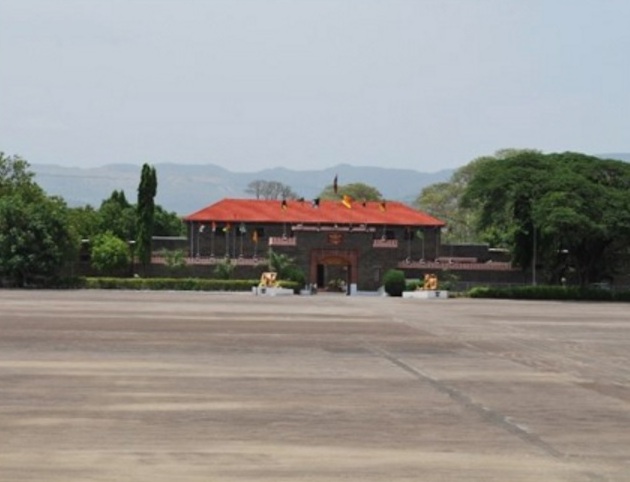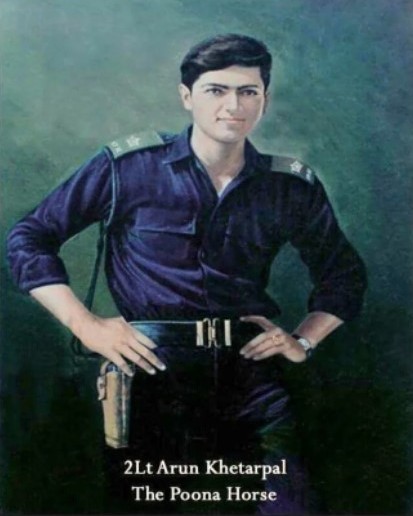Second Lieutenant Arun Khetarpal Wiki, Age, Death, Family, Biography & More
| Bio/Wiki | |
|---|---|
| Profession | Army Personnel |
| Famous For | Battle of Basantar (Indo-Pakistan War of 1971) |
| Military Service | |
| Service/Branch | Indian Army |
| Rank | Second Lieutenant |
| Service Years | 13 June 1971 - 16 December 1971 |
| Unit | 17 Poona Horse (Armoured Corps) |
| Service Number | IC-25067 |
| Career Ranks | Second Lieutenant (13 June 1971) |
| Career | |
| Awards, Honours, Achievements | • The Param Vir Chakra • Parade ground at NDA has been named after him  • A stadium has been named after him at his school, The Lawrence School Sanawar  |
| Personal Life | |
| Date of Birth | 14 October 1950 (Saturday) |
| Place of Death | Shakargarh Sector, Punjab Province, Pakistan |
| Age (at the time of death) | 21 Years |
| Birthplace | Pune, Bombay State (now Maharashtra), India |
| Death Cause | He died after being injured severely in the tank battle at the Battle of Basantar [1]Indian Army's Official Website |
| Zodiac sign | Libra |
| Signature |  |
| Nationality | Indian |
| Hometown | Pune, Maharashtra, India |
| School | The Lawrence School, Sanawar |
| College/University | • National Defence Academy, Khadakwasla • Indian Military Academy, Dehradun |
| Address | C-31, Anand Niketan, New Delhi, Delhi – 110021, India |
| Relationships & More | |
| Marital Status | Unmarried |
| Parents | Father- M. L. Khetarpal (a retired Brigadier) Mother- Maheshwari Khetarpal (a trained dietician)  |
| Siblings | Brother- Mukesh Khetarpal (working as a management consultant in Delhi) |
| Favourites | |
| Bike Collection | He owned a Jawa manufactured by Jawa Moto |
Some Lesser Known Facts About Arun Khetarpal
- Second Lieutenant Arun Khetarpal was an officer in the Indian Army, who was awarded the Param Vir Chakra, posthumously, for his gallant actions during the tank battle with the enemy at the Battle of Basantar during the Indo-Pakistan War of 1971. Arun Khetarpal died on 16 December 1971, because of the wounds he had sustained during the prolonged battle with the enemy.
- As a young child, Arun was sent to Lawrence School, Sanawar, where he stood out as not only an outstanding student but also an outstanding sportsman.
- Arun was, later on, made a school prefect for his outstanding and all-rounder performance.
- Arun was born into a family with rich military traditions. Arun’s father was also an officer in the Indian Army, who served in the Corps of Engineers.
- Arun’s family had relocated to India after the partition. He traced his roots back to Sargodha, Punjab Province, British India (now in Pakistan). [2]Yahoo News
- Having completed his schooling in 1967, Arun cleared the entrance examination and joined the National Defence Academy.
- Arun performed exceptionally well at the NDA. As a result of which, he was appointed as the Squadron Cadet Captain.
- After completing 3 years of rigorous training at the NDA, Arun was sent to the Indian Military Academy in 1970.
- Upon commissioning into the army, Arun was undergoing the Young Officers’ Course when the war between India and Pakistan broke out, Arun was recalled to his unit, the 17 Poona Horse, and was sent to the Western border with his unit.
- Arun’s unit was ordered to establish and secure a bridgehead at Shakarhgarhi Sector in Pakistan. On 15 December 1971, the Indian Army had captured Shakargarhi forcing the Pakistani troops and armoured columns to withdraw.
- On 16 December 1971, the Pakistani armoured column attacked the Indian tank column belonging to the ‘B’ Squadron of Poona Horse. The ‘B’ Squadron was attacked by an overwhelming number of enemy tanks, as a result of which, the B squadron asked for additional reinforcements.
- To this request, Arun Khetarpal responded immediately. Arun was the commander of the ‘A’ Squadron.
- Arun Khetarpal immediately led an assault against the counterattacking Pakistani tanks. Arun and his squadron destroyed many Pakistani tanks and thwarted their attempts to break through the Indian lines. [3]The Tribune
- During the final phase of the tank battle, Arun Khetarpal’s tank was damaged badly and had caught fire. The tank was rendered inoperable and as a result, it could not move.
- Arun’s tank was the last tank left of his squadron, and despite being grievously wounded, Arun Khetarpal continued to engage and fire at the enemy tanks and managed to destroy a total of 10 Pakistani state-of-the-art Patton tanks.
- Arun Khetarpal was ordered by his Commanding Officer to abandon the disabled fuming tank, to which Arun replied,
No Sir, I will not abandon my tank. My Main gun is still working and I will get these bastards.”
- While trying to take down the Pakistani armoured column commander, Major Khwaja Mohammad Naser’s tank, Arun Khetarpal’s tank took a final hit, as a result of which, he succumbed to his injuries.
- The tank with which Second Lieutenant Arun Khetarpal fought the battle of Basantar was a British origin Centurian Mark 7 tank. His tank was named Famagusta, a city in Cyprus where 17 Poona Horse had fought during the later stages of the Second World War.
- The damaged tank was later on repaired by the Indian Army and was installed at the Regimental Center of Armoured Corps at Ahmednagar, Maharashtra.
#FAMAGUSTA: The Centurion tank of #PoonaHorse commanded by #TheLegend 2nd Lt #ArunKhetarpal destroyed 8 Pak Patton Tanks in Battle of Basantar 1971. Honoured, privileged & blessed to be standing in front of it. With the present commandant. story soon on @IndiaToday #IndiaFirst pic.twitter.com/7oxOgWG1f2
— GAURAV C SAWANT (@gauravcsawant) October 13, 2018
- In 2001, Brigadier M. L. Khetarpal decided to go to Pakistan, to visit his ancestral hometown at Sargodha, Pakistan. There he became the guest of honour of another retired Brigadier of the Pakistani Army. His name was Khwaja Mohammad Naser, the man who had taken the final shot at Arun’s tank during the tank battle at the battle of Basantar.
- Khwaja Mohammad Naser, later on, talked to Arun’s father and told him everything that he had to say. He said,
Sir, there is something that I wanted to tell you for many years but I did not know how to get through to you. Finally, fate has intervened and sent you to me as an honoured guest. The last few days we have become close to one another and that has made my task even more difficult. It is regarding your son who is, of course, a national hero in India. However, on that fateful day, your son and I were soldiers, unknown to one another, fighting for the respect and safety of our respective countries. I regret to tell you that your son died in my hands. Arun’s courage was exemplary and he moved his tank with fearless courage and daring, totally unconcerned about his safety. Tank casualties were very high till finally there were just two of us left facing one another. We both fired simultaneously. It was destined that I was to live and he was to die. It was only later that I got to know how young he was and who he was. I had all along thought that I would ask your forgiveness, but in telling the story I realize that there is nothing to forgive. Instead I salute your son for what he did at such a young age and I salute you too, because I know how he grew into such a young man. In the end it is character and values that matter.”
- After the declaration of the ceasefire on 16 December 1971, the Pakistani tank commander, Khawaja Mohammad Naser, went to Arun Khetarpal’s disabled tank inquiring about the brave officer, who alone had faced so many Pakistani tanks. He asked the Indian troops, “Your Saheb fought very bravely on the battlefield, I hope he is not wounded. To which the Indian troops replied, “Saheb got martyred and is no more.” [4]The Times of India
- Before going to the war, a senior officer noticed Arun carrying around his suit and the ceremonial military dress to the battlefield. In an article written later by Dilbagh Singh Dabas, the author wrote,
Having noticed Arun carrying his ceremonial Blue Patrol clothing and golf clubs along, his fellow officer asked Arun that why he needed these on way to fighting a war. And the reply by the 21-year-old was classic: Sir, I plan to play golf in Lahore. And I am sure there will be a dinner night after we win the war, so I’ll need the Blue Patrol dress as well.” [5]The Tribune
- Before leaving for the 1971 India-Pakistan War, Arun was at his home, on leave. While the family was having dinner, Arun’s mother told him,
Your grandfather was a brave soldier, so is your father. Go fight like a lion till the end.” [6]The Tribune
- Had it not been for the actions of Second Lieutenant Arun Khetarpal, the Pakistani armoured columns would have made a breakthrough, through the Indian defences. In an article written by a Pakistan Army officer, Major (retired) A. H. Amin, he stated,
The only occasion when a breakthrough could have occurred was when two squadrons of 13 Lancers attacked together in the afternoon, but a gallant last ditch lone stand by 2/Lt Arun Khetarpal of Poona Horse averted the danger.”
- Arun Khetarpal also had a keen interest in music. Therefore, he learned how to play the saxophone. Arun was so good at playing the instrument that he was even made a part of the National Defence Academy’s musical band.
- Reports about the making of a biographical film titled ‘Ekkis’ on Arun Khetarpal emerged in January 2024; his role was reported to be portrayed by actor Agastya Nanda in the film.
References/Sources:
















